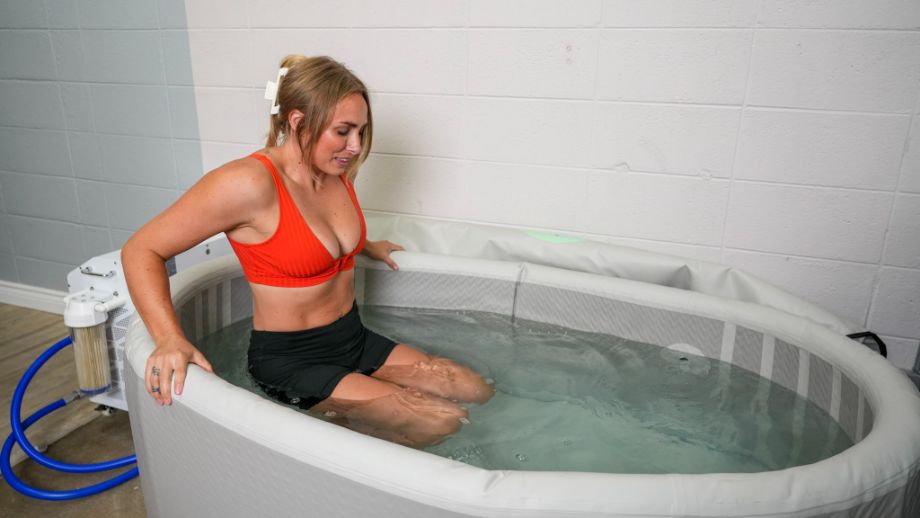We test and review fitness products based on an independent, multi-point methodology. If you use our links to purchase something, we may earn a commission. Read our disclosures.
Are you a fan of Wim Hof, aka “The Iceman?” Do you listen to Andrew Huberman’s wildly successful podcast? Have you heard about professional athletes, including Tom Brady, Cristiano Ronaldo, and Usain Bolt, who use cold plunging, ice baths, cryotherapy, and other forms of cold therapy to help improve their muscle recovery and enhance athletic performance?
RELATED: Best Muscle Recovery Tools
Cold therapies, like the cold water plunge, have never been hotter than they are today. Folks, now more than ever, are learning about the potential benefits of cold plunging and adding it to their regular health and wellness routines.
We sat down with Dr. Michael Masi, DPT and Founder of Masi Fitness, to discuss what the cold plunge is, ideal temperature range, how to cold plunge, how long to cold plunge, how often to cold plunge, and the health benefits associated with cold plunging so you’ll have everything you need to try it out yourself!
What Is a Cold Plunge?
“Cold plunges involve immersing yourself into cold water to receive health benefits associated with exposure to cold temperatures,” explains Dr. Masi. “Generally, the immersion is brief, only a few minutes at a time, but the stimulus creates a physiological response and, in turn, results in potential health benefits.”
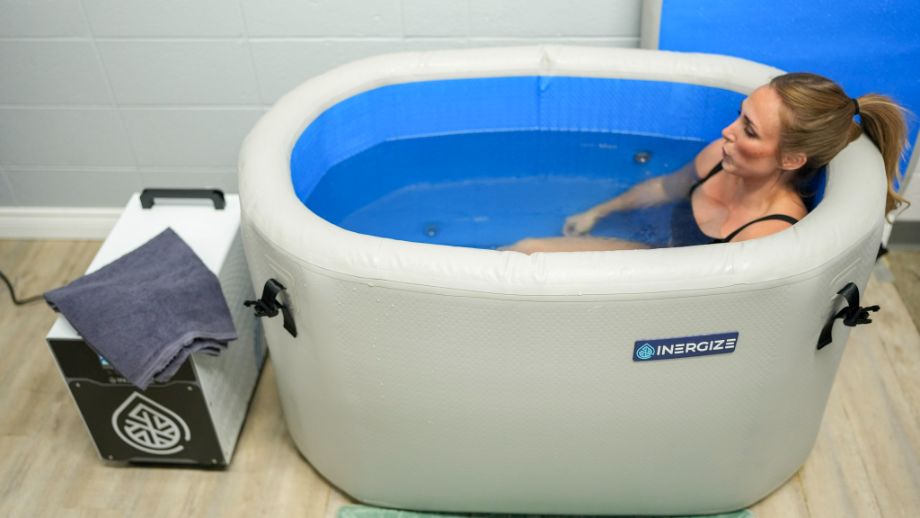
The cold plunge is just one method of administering cold therapy, with other methods including cryotherapy, ice baths, cold showers, and cold water swimming.
RELATED: Ice Bath Benefits
How to do Cold Plunge
Here’s our step-by-step guide on how to ice plunge like a pro:
- Fill your ice bath or bathtub with cold water: The ideal cold plunge temperature is between 53 to 60 degrees Fahrenheit. Start warmer and progress to colder temperatures with more plunge practice.
- Prepare a timer for anywhere between 2-10 minutes: If you’re brand new, you can start with 30 to 60 seconds, working up to longer durations with more cold plunge experience. More experienced folks can tolerate 10-15 minutes.
- Breathe before you dunk: You’ll want to make sure you’re using a breathing technique that works for you (our cold plunge testers like the Wim Hof Method). We suggest practicing a few breaths before you get into the ice bath and continuing once you’re in.
- Enter slowly: It’s quite the shock, so don’t worry about trying to rush in. Take your time and work on breathing while your start to submerge.
- Hit that timer you prepared once you’re in the ice bath!
- Focus your mental effort on your breath: Rather than thinking about how darn cold you are, focus your attention to your breathing and the breathwork pattern you’ve chosen.
- Exit the cold plunge: Slowly warm yourself back up.
There are many ways to cold plunge including hopping in the nearest body of cold water. But if you’re wondering how to cold plunge at home you have a few options: Fill your bathtub with cold water and ice, DIY a cold plunge with stock tank, or purchase one of the best cold plunge tubs for your home and set up your own cold plunge in a pinch.
RELATED: DIY Cold Plunge Tuff Stuff Stock Tank Review
You’ll be tempted to jump into a hot shower and get toasty right away, but fight the urge! Warming up slowly and naturally avoids shocking the system further and maximizes the benefits of the cold plunge.
If you’re in a rush, wrap yourself in a warm, dry towel or sip a warm beverage.
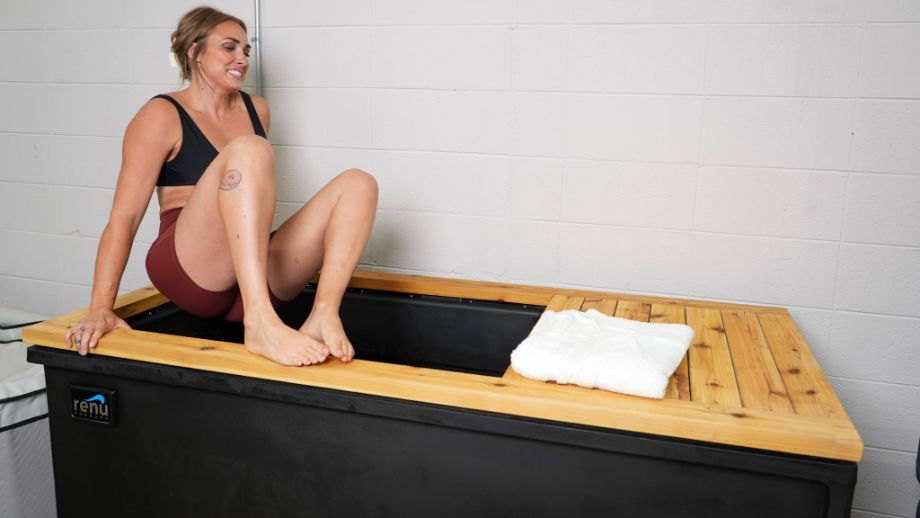
How to Prep to Cold Plunge
If you’re nervous about hopping into a cold plunge, here are a few tips from a certified personal trainer on how to take the plunge.
- Breathe and Relax: Before getting into the water, take controlled breaths (inhale through the nose, exhale through the mouth). This calms your body and prepares it for the shock of entering the cold water by lowering your heart rate. The worst thing you could do is enter a tub while still excited or nervous.
- Start slowly: This means start at a relatively higher temperature, closer to 40 degrees than freezing, and a short period before spending 3-5 minutes in a tub that’s set to freezing temperatures.
- Set a timer: Use your smartphone to set a timer for the amount of time you want to spend in the tub.
- Have a towel nearby: Just as you wouldn’t get into a shower without a towel to dry off and warm up, you should also have one close to your cold plunge before getting in.
What’s Happening During a Cold Plunge?
A 2022 study published in the International Journal of Circumpolar Health1 describes what happens to your body during a cold plunge.
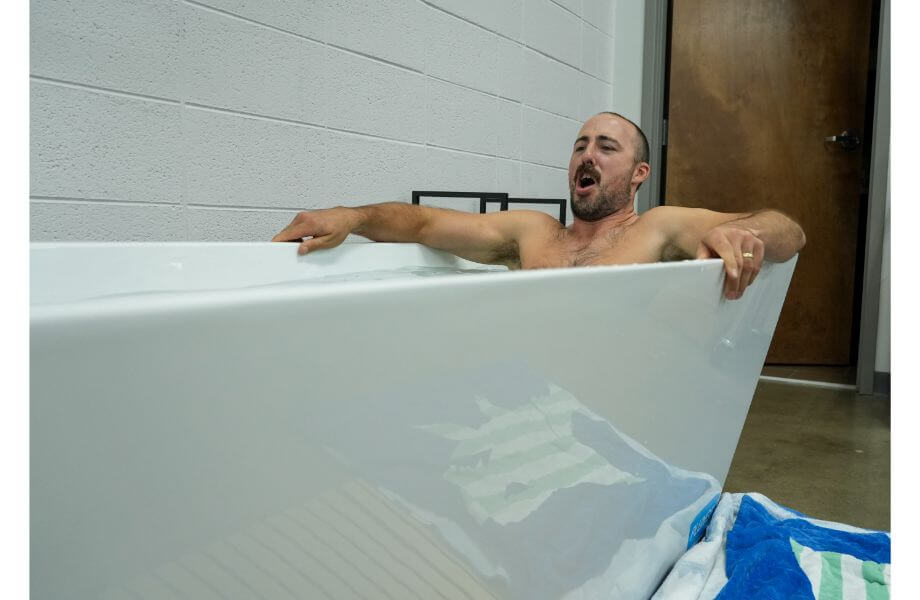
The cold exposure challenges the body to acclimate and produce heat to maintain a safe body temperature. Thermoregulation is achieved through various means, including:
- Thermogenesis through shivering
- Thermogenesis through brown adipose tissue activation
- Cold-induced vasodilation2, or increased blood flow
Basically, your body knows it needs to warm up in order to protect your vital organs and continue performing the metabolic processes, so you start shivering, which generates heat, your blood vessels fluctuate between dilation and constriction, improving the flow of warm blood towards the surface of the skin, and even your fat deposits, specifically “brown adipose tissue,” create heat as well.
RELATED: Polar Monkeys Cold Plunge Review
Health Benefits of a Cold Plunge
You may have seen pro athletes—and folks on TikTok and social media—using ice plunges for their potential health benefits, but what exactly are those benefits?
May Help Boost Immune System
Clinical trials3 determined that cold water immersion produced “immunostimulating effects,” specifically an increased “leukocyte, granulocyte, and monocyte response.”
“Leukocytes, granulocytes, and monocytes are types of white blood cells that fight against infections and diseases,” says Dr. Masi, “so it is theorized that the augmented response of disease-fighting white blood cells due to cold water exposure has a positive effect on your immune system.”
RELATED: Wet Sauna vs Dry Sauna Benefits
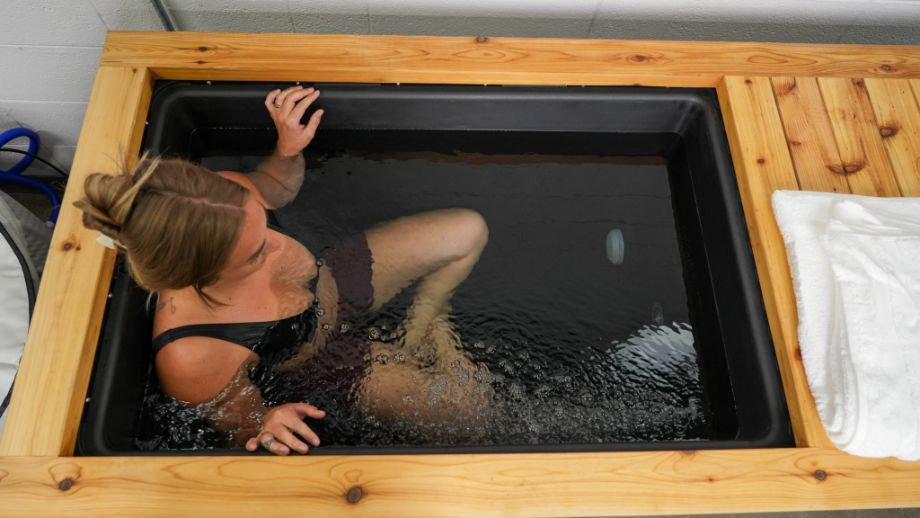
May Aid in Muscle Recovery
Numerous studies have been conducted over the years to determine if cold water immersion therapies like the cold plunge assist in muscle recovery.
Some studies4 have found it to be an effective practice, similar to active recovery, for reducing delayed-onset muscle soreness (DOMS) and fatigue and encouraging muscle recovery, while other studies5 found the practice to be harmful to resistance training adaptations while providing no benefit to aerobic exercise performance.
RELATED: What Is Active Recovery?
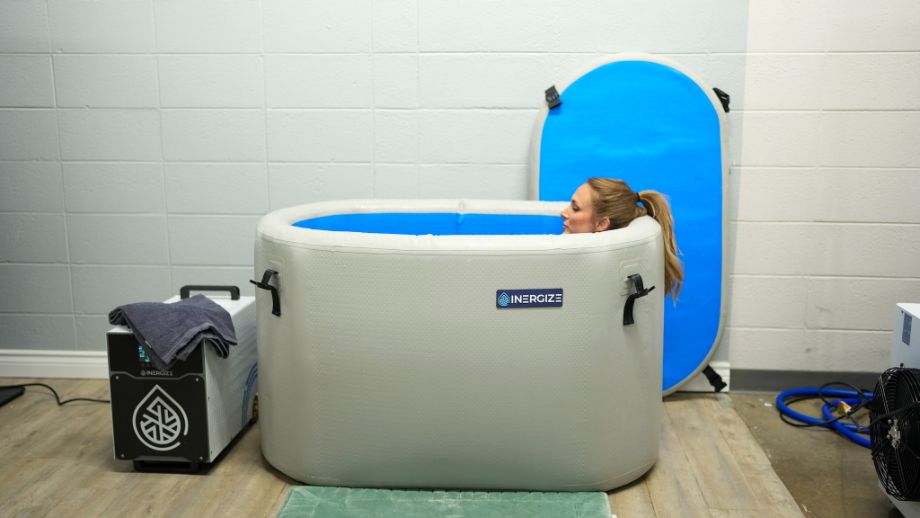
A 2023 study published in Frontiers in Physiology6 sought to finally make heads or tails of the conflicting data, ultimately determining that “subjective sensations seemed to recover immediately [following cold water immersion], as did objective biochemical markers such as [creatine kinase] and lactate.”
These results indicate that, after a workout, a cold plunge might be just the thing to reduce muscle soreness and start the process of muscle recovery.
RELATED: Cold Plunge Before or After Workout?
May Boost Mood
You probably won’t feel great the second you slip into a cold plunge, but could the practice yield mental health benefits? Studies show that they may.
A 2008 study published in Medical Hypotheses7 posited that cold water exposure, specifically by taking cold showers, could have a positive effect on depression. The study found that the cold water exposure activated the sympathetic nervous system, increasing the release of endorphins and noradrenaline to the brain and concluding that “cold hydrotherapy can relieve depressive symptoms rather effectively.”
RELATED: Ice Bath vs Cold Shower
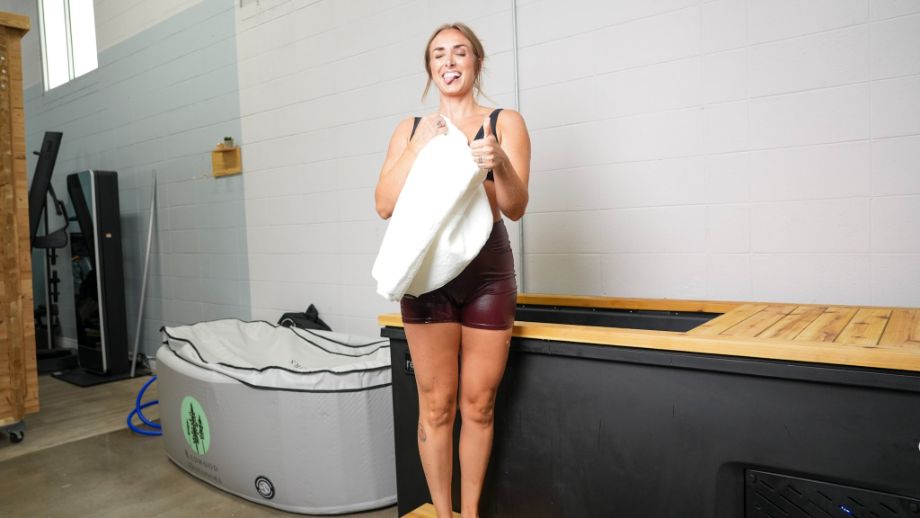
A 2023 study in BMJ Military Health8 corroborated these findings, stating that “regular [cold water] exposure positively impacts mental status and physical composition, which may contribute to higher psychological resilience” and that “cold exposure as a part of military training is most likely to reduce anxiety among soldiers.”
May Help Improve Sleep
Improved sleep may also be among the positive effects of cold water immersion.
A 2012 study published in the International Journal of Sports Physiology and Performance9 found that as little as five minutes of cold water immersion following training sessions resulted in improvements in the perceived sleep quality and overall well-being in highly-trained swimmers.
Potential Risks of a Cold Plunge
Although there are plenty of possible health benefits to submerging into cold water there are also potential risks. If you have cardiovascular disease, high blood pressure, heart arrhythmia, or other heart diseases you should consult your doctor before trying to plunge. During a cold plunge your body’s natural response is to alter blood flow to regulate your internal temperature which may place too much strain on the heart and cardiovascular system.
RELATED: Does Cardio Lower Blood Pressure?
Additionally, cold shock is a potential risk of ice baths and cold plunges, especially if you are new to cold exposure. Healthy individuals can reduce the risk of cold shock by starting with mild temperatures for short periods of time and working up to colder water and longer bouts.
How to Cold Plunge: FAQs
How do you cold plunge properly?
“Cold plunges trigger your body to release norepinephrine, which activates your body’s ‘fight or flight’ response,” says Dr. Michael Masi, DPT, SCS, CSCS, CISSN, USAW-1, and owner of Masi Fitness. “Most beginners need to consciously calm themselves back down to a neutral state using breath control and meditation.”
Take deep breaths before you plunge, and as soon as you enter the water, slow that breathing down even more. If it helps, give yourself a pep talk, reminding yourself that you are totally okay. Letting out a yoga “Om” or humming may help as well.
Remember—if you feel the cold temperature is too intense, get out immediately and warm yourself up. And, of course, consult your doctor before undergoing cold therapies of any kind.
What not to do after a cold plunge?
Although you may be tempted to get warmed up after the cold plunge, jumping directly into a hot shower or sauna is generally not recommended.
RELATED: 6 Dry Sauna Benefits To Convince You To Sweat It Out
Instead, allow your body time to return to homeostasis naturally before forcing it to adapt to extreme temperature fluctuations again.
Are cold plunges really good for you?
Yes, cold plunges have proven benefits for athletes and everyday people, including:
Improved immunity
Improved muscle recovery
Improved mental health
Improved sleep
What is the protocol for the cold plunge?
Fill your ice bath or bathtub with cold water
Prepare a timer for anywhere between 2-10 minutes
Breathe before you dunk
Enter slowly
Hit that timer you prepared once you’re in the ice bath!
Focus your mental effort on your breath
Exit the cold plunge
References
1. Esperland D, de Weerd L, Mercer JB. Health effects of voluntary exposure to cold water – a continuing subject of debate. Int J Circumpolar Health. 2022;81(1):2111789. doi:10.1080/22423982.2022.2111789
2. Flouris AD, Westwood DA, Mekjavic IB, Cheung SS. Effect of body temperature on cold induced vasodilation. Eur J Appl Physiol. 2008;104(3):491-499. doi:10.1007/s00421-008-0798-3
3. Brenner IK, Castellani JW, Gabaree C, et al. Immune changes in humans during cold exposure: effects of prior heating and exercise. J Appl Physiol (1985). 1999;87(2):699-710. doi:10.1152/jappl.1999.87.2.699
4. Peake JM, Roberts LA, Figueiredo VC, et al. The effects of cold water immersion and active recovery on inflammation and cell stress responses in human skeletal muscle after resistance exercise. J Physiol. 2017;595(3):695-711. doi:10.1113/JP272881
5. Malta ES, Dutra YM, Broatch JR, Bishop DJ, Zagatto AM. The Effects of Regular Cold-Water Immersion Use on Training-Induced Changes in Strength and Endurance Performance: A Systematic Review with Meta-Analysis. Sports Med. 2021;51(1):161-174. doi:10.1007/s40279-020-01362-0
6. Xiao F, Kabachkova AV, Jiao L, Zhao H, Kapilevich LV. Effects of cold water immersion after exercise on fatigue recovery and exercise performance–meta analysis. Front Physiol. 2023;14:1006512. Published 2023 Jan 20. doi:10.3389/fphys.2023.1006512
7. Shevchuk NA. Adapted cold shower as a potential treatment for depression. Med Hypotheses. 2008;70(5):995-1001. doi:10.1016/j.mehy.2007.04.052
8. Néma J, Zdara J, Lašák P, et al. Impact of cold exposure on life satisfaction and physical composition of soldiers [published online ahead of print, 2023 Jan 4]. BMJ Mil Health. 2023;e002237. doi:10.1136/military-2022-002237
Further reading

Looking for a protein powder that won’t upset your stomach? Here are our top picks for the best gluten-free protein powder. Read more

It’s the ultimate showdown: cardio vs weights for weight loss. We set out to finally answer this controversial question. Read more

Looking to take your core training to the next level? Cable ab workouts prove that you can do plenty of core exercises without lying down on the job! Read more

Our Epicured review breaks down the ordering process, meal plans, pricing, and more of this low FODMAP and gluten-free meal delivery service. Read more

